49 Self-Driving Car Accident Rate Statistics & Facts
Did you know that there were 5 deaths and 6 serious injuries in the 392 self-driving car crashes from June 2021 to May 2022?
You’re about to see a list of the latest self-driving cars statistics.
Read on to find new self-driving car statistics related to:
- How many self-driving cars are there?
- How many self-driving cars have crashed?
- How many deaths have self-driving cars crashed?
- Self-driving car accident rate
- Self-driving car market size and growth
- Much more
Read on!
Key Self-Driving Car Statistics
- A new study reports that there were 5 deaths and 6 serious injuries in the 392 self-driving car crashes reported to the National Highway Traffic Safety Administration from July 2021 to May 2022.
- The autonomous vehicles industry grows by 16% globally on a yearly basis.
- Approximately 9.1 driverless car crashes happen per million miles driven.
- There have been approximately 37 Uber test vehicle crashes.
- 11 Tesla self-driving car accidents have been reported in the last 4 years.
- Waymo has 600 driverless cars, and their cars have been involved in 18 car accidents over a 20-month period.
- The autonomous vehicle global market is expected to reach $37 billion by 2023.
- North America owns 29% of all the self-driving vehicles globally.
- 55% of small businesses believe that they’re going to have a fully self-driving fleet in the next 20 years.
- 57% of people who are familiar with self-driving cars report that they would be willing to ride inside them.
- 16% of residents report feeling comfortable letting a fully self-driving vehicle drive them around.
Chapter 1: Driverless Car Statistics
| Autonomous vehicle global market | $37 billion by 2023 |
| Autonomous vehicles industry growth rate | 16% every year |
| Number of driverless car crashes per million miles driven | 9.1 |
| Percentage of self-driving cars North America owns | 29% |
| Percentage of people willing to ride inside self-driving cars | 57% |
| Number of Tesla self-driving car accidents | 11 in the last 4 years |
| Number of Uber test vehicle crashes | 37 |
| Number of Wayno driverless cars | 600 |
| % of Americans who believe self-driving cars will never be safe | 20% |
- A new study reports that there were five deaths and six serious injuries in the 392 self-driving car crashes reported to the National Highway Traffic Safety Administration from July 2021 to May 2022.
- The autonomous vehicles industry grows by 16% globally on a yearly basis.
- Approximately 9.1 driverless car crashes happen per million miles driven.

- The autonomous vehicle global market is expected to reach $37 billion by 2023.
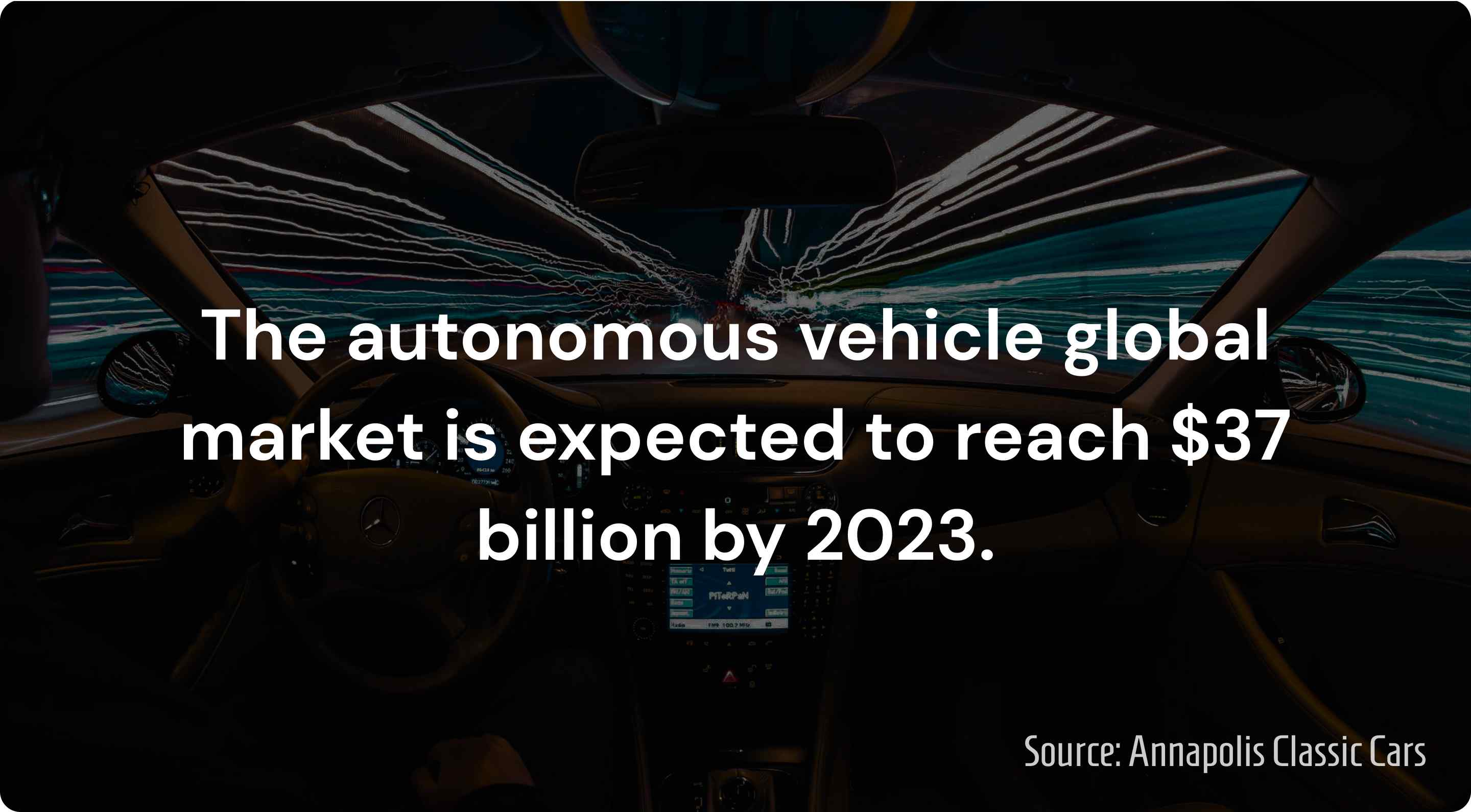
- North America owns 29% of all the self-driving vehicles globally.
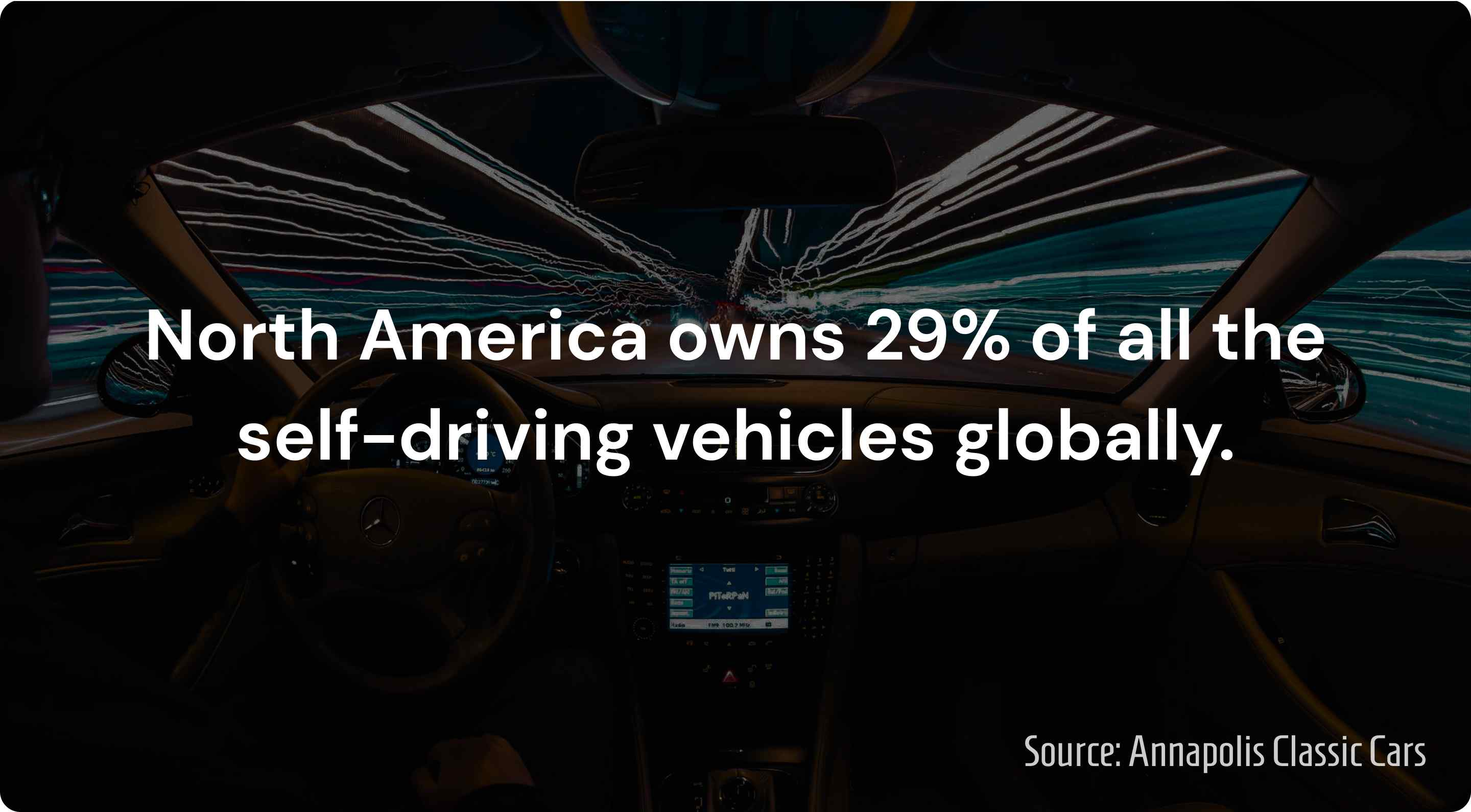
- 55% of small businesses believe that they’re going to have a fully self-driving fleet in the next 20 years.
- 57% of people who are familiar with self-driving cars report that they would be willing to ride inside them.
- 16% of residents report feeling comfortable letting a fully self-driving vehicle drive them around.

Chapter 2: General Driverless Car Accident Statistics
- On average, a fatality occurs every 94 million miles in the U.S.
- On average, a fatality occurs every 60 million miles globally.
- Tesla’s Autopilot had been used for more than 130 million miles until its first fatal accident. Despite the announcement from Tesla, this isn’t an apples-to-apples comparison since autopilot vehicles are used more frequently on highways.

- AVs get into more crashes overall: 9.1 crashes per million miles driven. Conventional vehicles get involved in a crash 4.1 times per million miles driven. Interestingly, the ones involving injury were minor compared with the injuries car users received during conventional vehicle crashes.
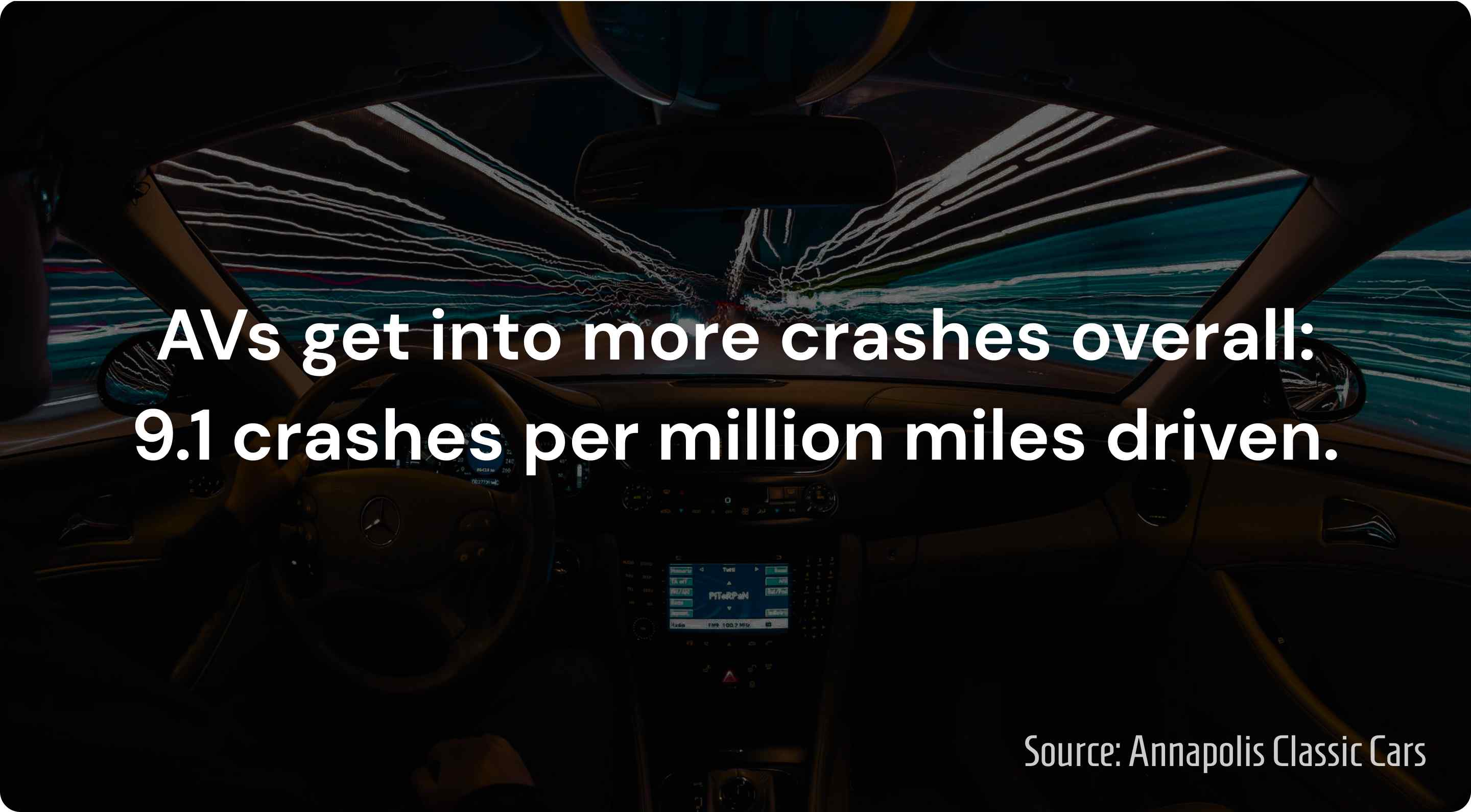
- Google’s self-driving car, Lexus SUV, crashed with a bus in February 2016.
- Google’s Waymo had 18 minor accidents between 2019 to the first 9 months of 2020.
- The Uber crash in Tempe on November 20th, 2018 was the first recorded case of a pedestrian fatality involving a self-driving car. Uber’s self-driving cars were involved in 37 minor crashes before the crash that led to Elaine Hezerberg’s death.
- The company determined that the Arizona car crash was caused by the car’s sensors identifying the pedestrian, but considering the victim as a “false-positive”.
- While in autopilot mode, both Tesla Model 3 and Tesla Model S caused fatal accidents in March 2019 and June 2016 where the driver died.
- In 1939, the first autonomous car concept was introduced at the New York World’s Fair.
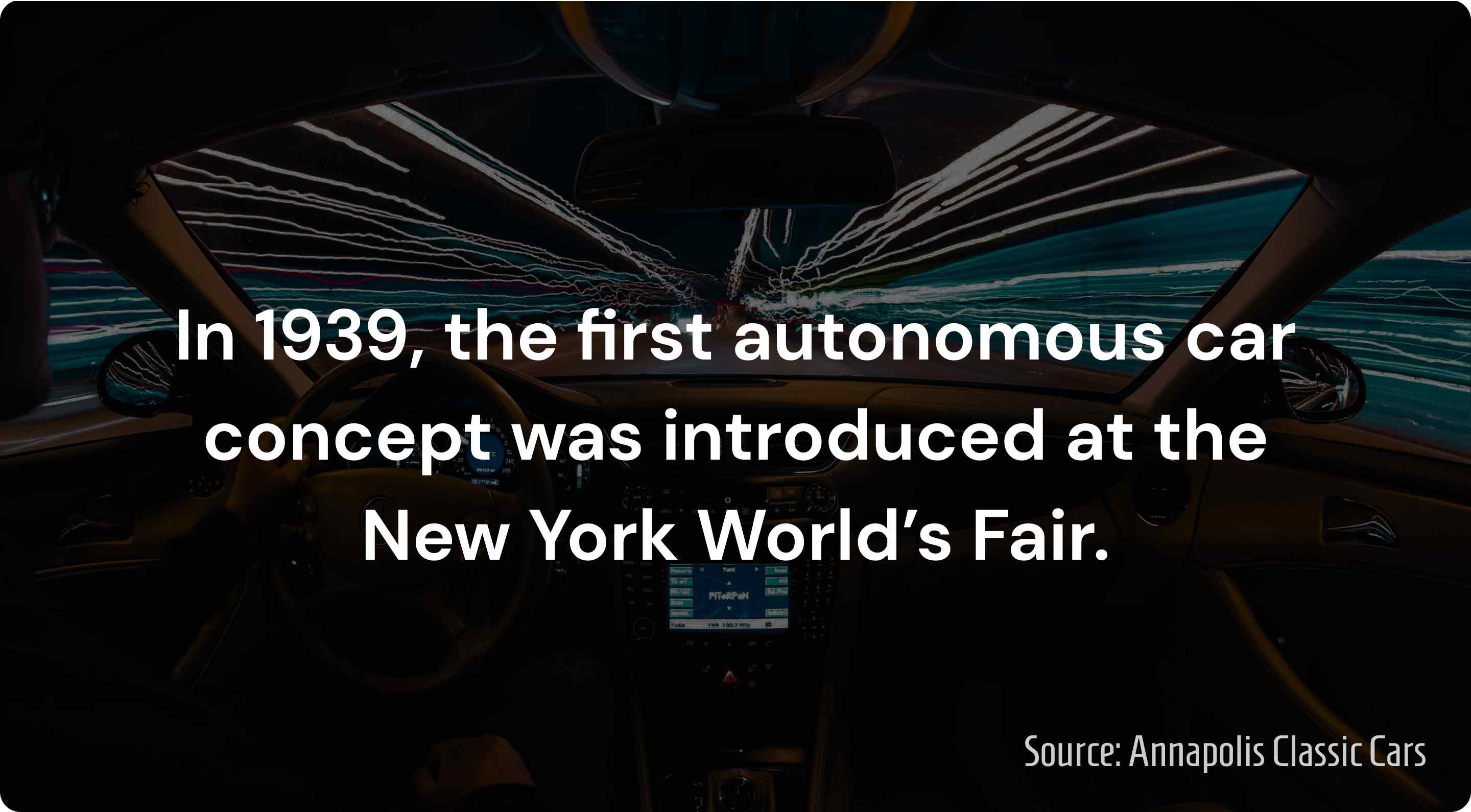
- By 2030, annual production levels of robo-cars are predicted to reach a jaw-dropping 800,000 units worldwide.

Chapter 3: Google Self-Driving Car Accident Statistics
1. In February 2016, Google’s self-driving Lexus SUV crashed with a bus for the first time.
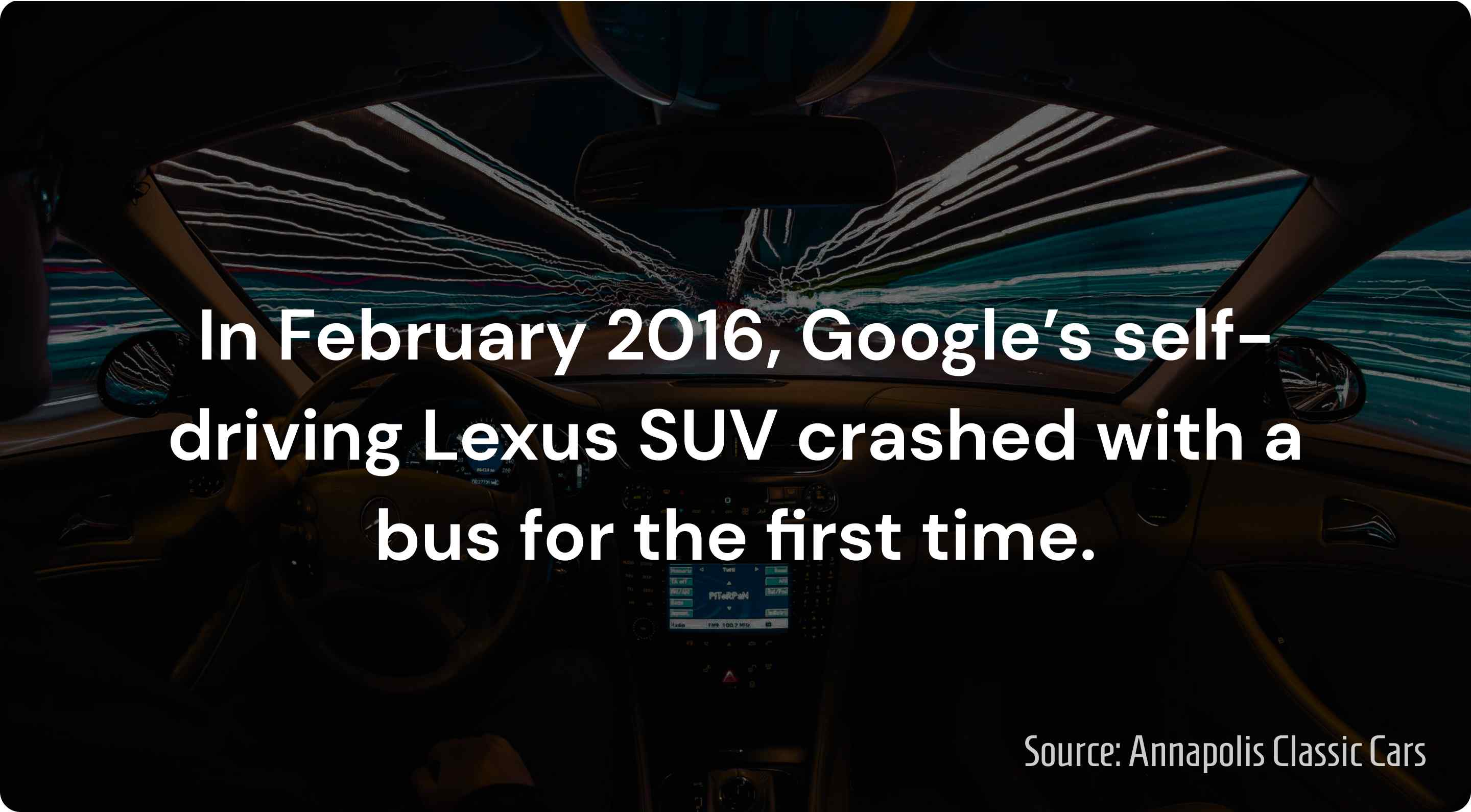
The Lexus SUV, in autonomous mode, was driving 2 mph, and the bus was driving 15 mph. Overall, it was a minor crash and there weren’t any injuries reported. (Wired)
2. A Honda Sedan crashed into a Waymo self-driving van resulting in minor injuries.

Just two years later, Google once again found its car in a crash where the Waymo van was in manual mode, and the sedan swerved to avoid another human driver and therefore crashed into the Waymo van - which is why the self-driving van wasn’t at fault. (USA Today)
Chapter 4: Tesla Autonomous Car Accident Statistics
1. 11 Tesla self-driving car accidents have been reported in the last 4 years.

2. Tesla Model S was the self-driving car to cause its first death in Florida while in autopilot mode.
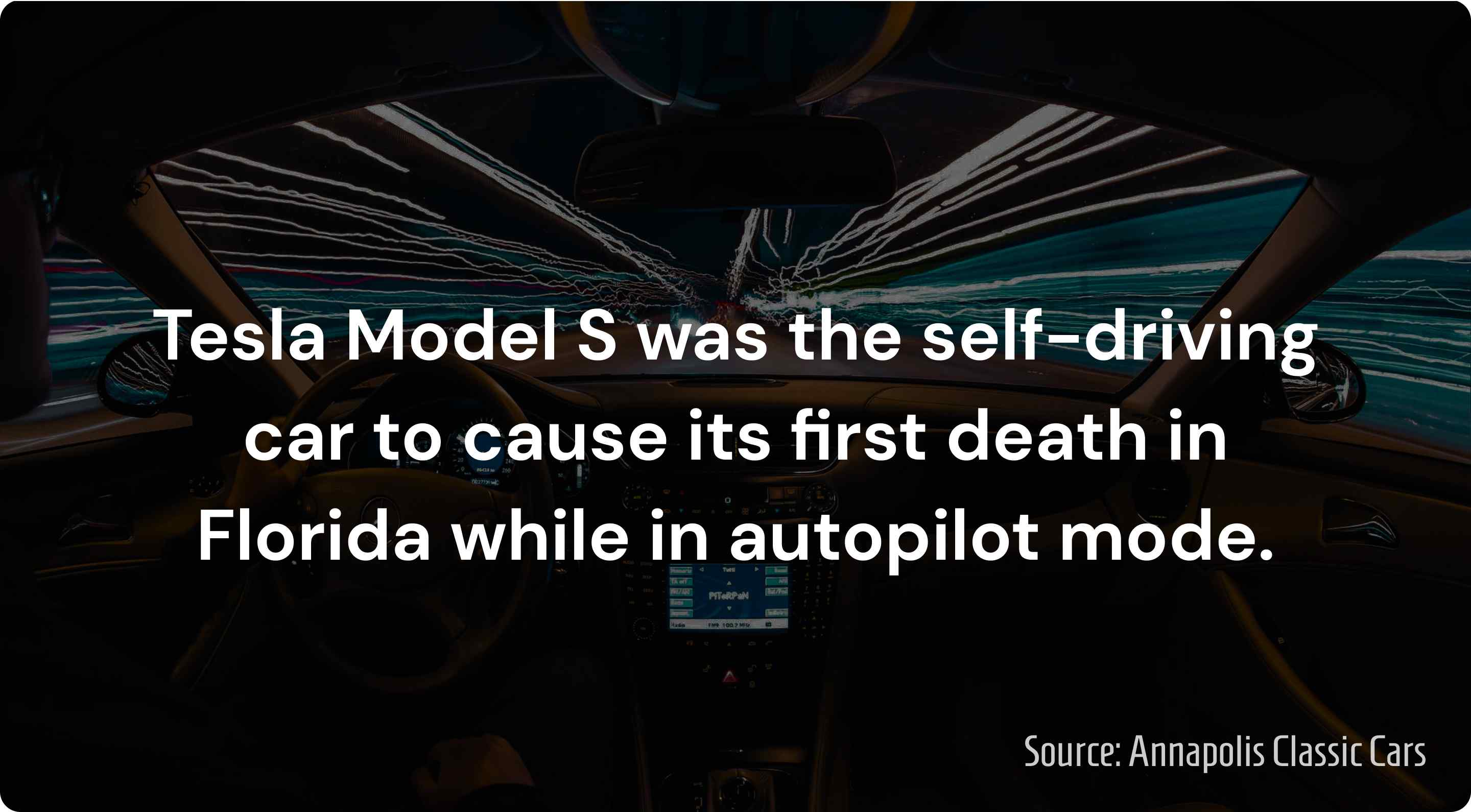
On May 7th, 2016, the accident took place where Tesla’s autopilot sensors failed to recognize a white tractor-trailer crossing the highway.
The car was put in autopilot mode by Joshua Brown, the driver. Unfortunately, the self-driving vehicle wasn’t able to distinguish the truck that was crossing the highway, and it therefore attempted to drive through it at full speed.
The tragic result was the death of the Tesla driver due to the injuries he received from the crash. (The Guardian)

3. The latest safety data report released by Tesla showed that its autopilot is safer than a human driver. (Futurism)

Chapter 5: Uber Self-Driving Cars Statistics
- There have been approximately 37 Uber test vehicle crashes. (Business Insider)
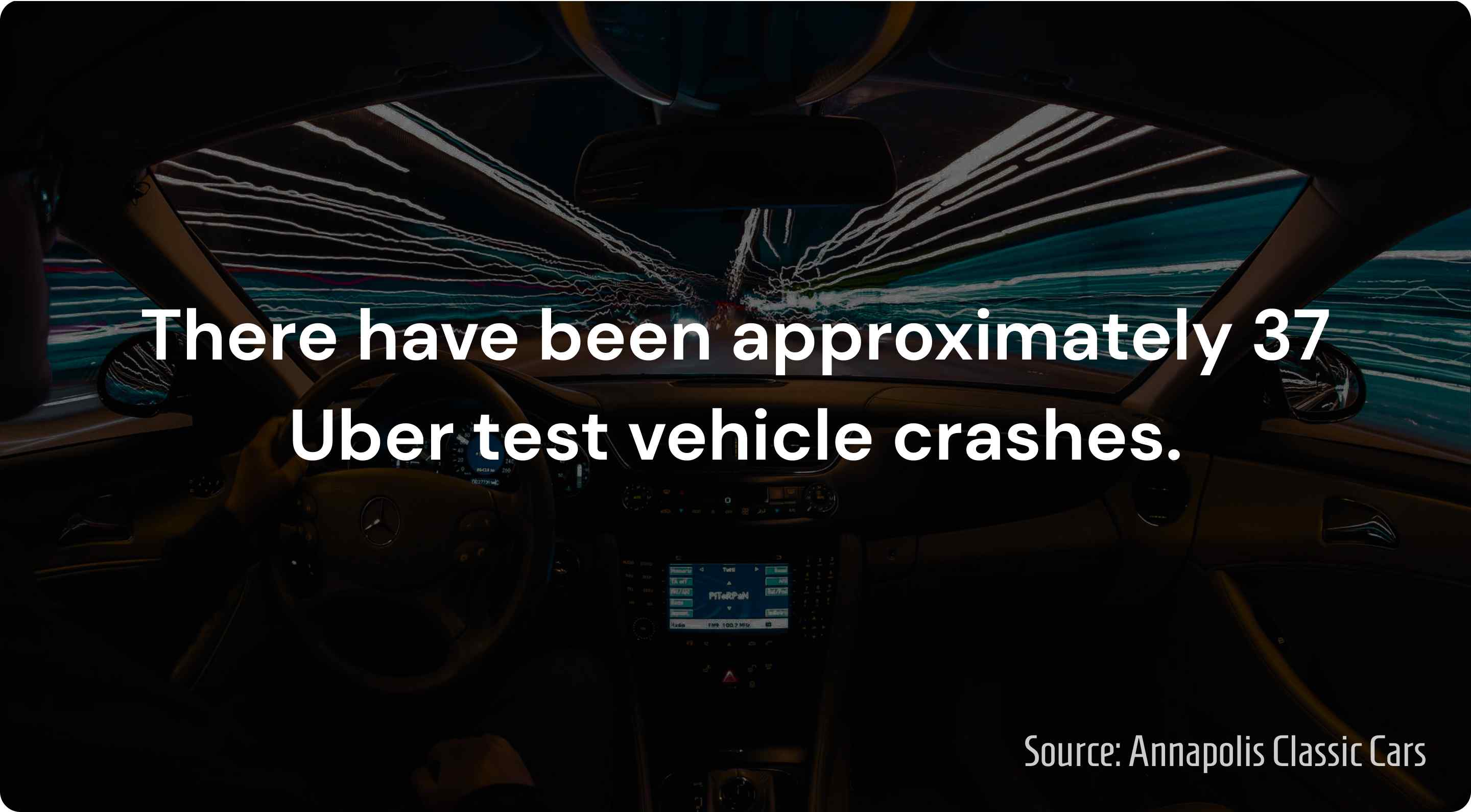
- On November 20th, 2018, the first Uber self-driving car crash took place in Tempe, Arizona because of human error. (The Verge)
- Two years passed after the fatal Uber car accident before Uber self-driving vehicles were allowed on California roads again. (BBC)
Chapter 6: Waymo Self-Driving Cars Statistics
Waymo has 600 driverless cars, and their cars have been involved in 18 car accidents over a 20-month period. In 2020, Waymo has driven 20 million miles on public roads in 25 different U.S. cities.
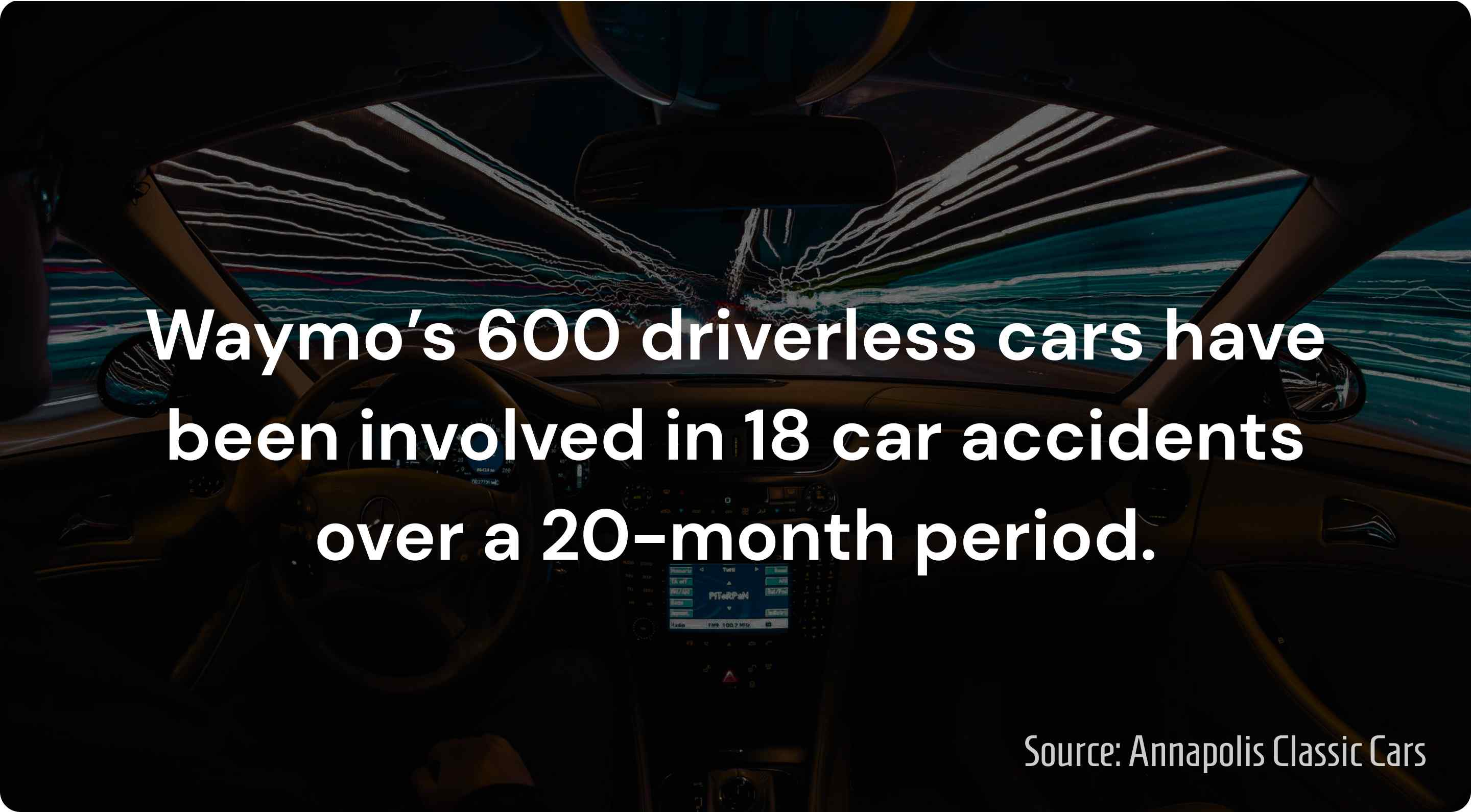
Using synthetically generated data, Waymo has conducted more than 20 billion miles of simulation testing.
Research has shown that Waymo’s self-driving cars require the least number of manual intervention, and Uber’s self-driving vehicles need the most.
Chapter 7: Self-Driving Cars Safety Statistics
How Safe Are Self-Driving Cars?
- 20% of American respondents believe autonomous vehicles will never be safe. (The Verge)
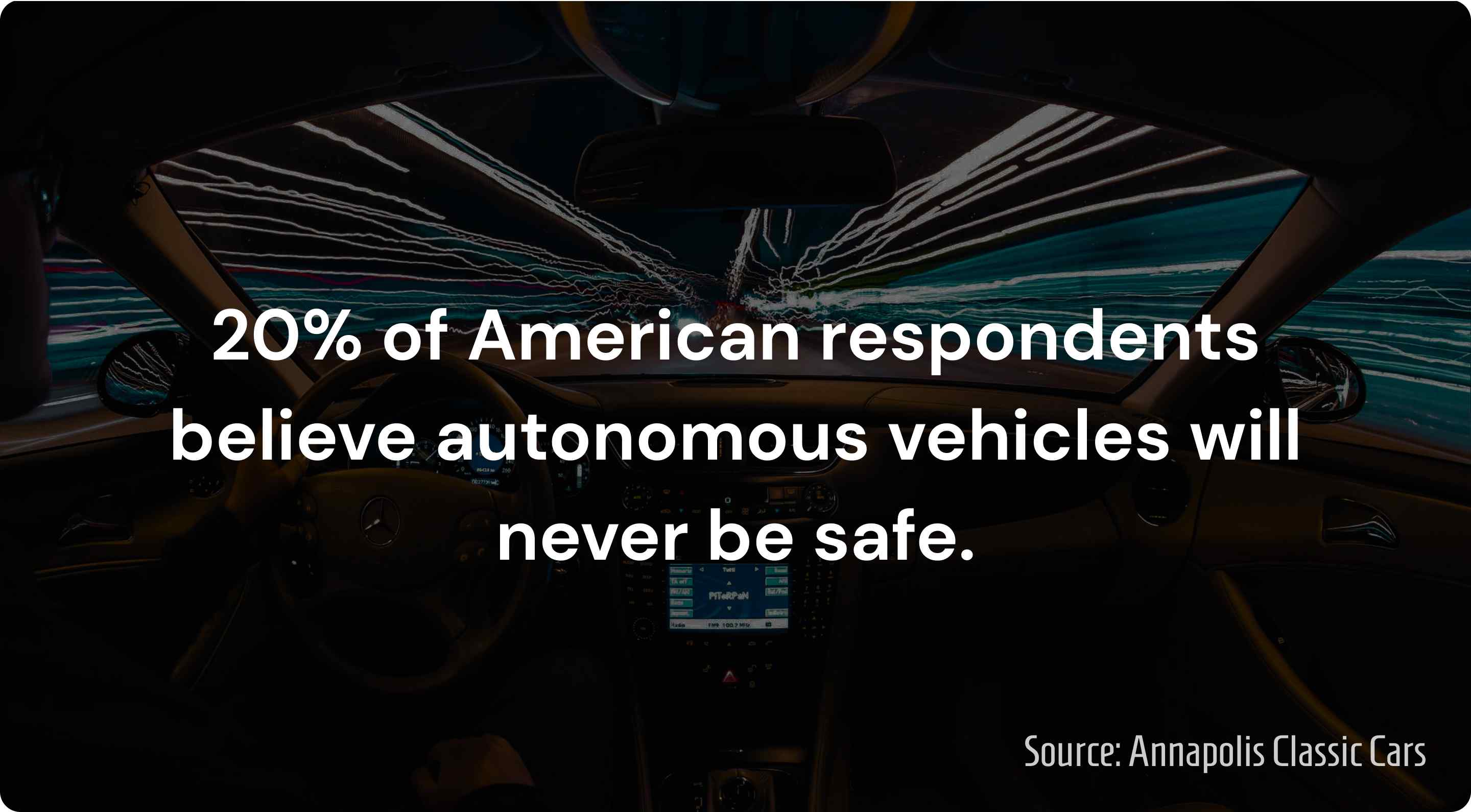
- Just 12% of U.S. respondents state they feel safe in self-driving cars. (The National Law Review)
- Self-driving cars will cause more traffic jams. (University Of Western Australia)
Chapter 8: Investments In Self Driving Vehicles
Biggest Self-Driving Car Companies
| Company | Total raised funding |
| Waymo | $5.5 billion |
| Tesla | $20.2 billion |
| Uber | $1 billion |
| Zoox | $1 billion |
| Aurora | $2.1 billion |
| Nuro | $2.1 billion |
| Cruise | $15.1 billion |
| Rivian | $10.7 billion |
- Audi plans to spend around $16 billion on self-driving and sustainable tech by 2023. (CBNInsights)
- Waymo has raised a total of $5.5 billion in funding over 3 rounds. Their latest funding was raised on Jun 16th, 2021 from a Private Equity round. (Crunchbase)
- Tesla has raised a total of $20.2 billion in funding over 36 rounds. Their latest funding was raised on May 9th, 2020 from a Post-IPO Debt round. (Crunchbase)
- Uber has raised a total of $1 billion in funding over just 1 round to make self-driving technology safer, as well as to further their research. This was a Corporate Round raised on Apr 19th, 2019. (Crunchbase)
- Zoox has raised a total of $1 billion in funding over just 6 rounds. Their latest funding was raised on Oct 21th, 2019 from a Convertible Note round. (Crunchbase)
- Aurora has raised a total of $2.1 billion in funding over 7 rounds. Their latest funding was raised on Nov 4th, 2021 from a Post-IPO Equity round. (Crunchbase)
- Nuro has raised a total of $2.1 billion in funding over 6 rounds. Their latest funding was raised on Nov 2th, 2021 from a Series D round. (Crunchbase)
- Cruise has raised a total of $15.1 billion in funding over 13 rounds. Their latest funding was raised on Mar 18th, 2022 from a Secondary Market round. (Crunchbase)
- Rivian has raised a total of $10.7 billion in funding over 10 rounds. Their latest funding was raised on Jul 23th, 2021 from a Private Equity round. (Crunchbase)
Chapter 9: How Do People Feel About Self-Driving Cars?
People's Opinions On Self-Driving Vehicles
- Just 16% of respondents are “very likely” to ride as a passenger in a self-driving vehicle.
- 28% of respondents state they are “not likely at all” to ride as a self-driving vehicle passenger.
- 22% of respondents believe self-driving cars are safer than the average human driver. 355 of them believe self-driving cars are less safe than the average human driver.
- 51% of U.S. citizens are interested about laws to ensure self-driving cars are safe to use.
- 57% of Americans who are familiar with self-driving cars are comfortable to ride in them.
- 72% of U.S. adults state they would feel safer riding in a self-driving car if they had the ability to take over control if something ends up going wrong.
- 57% of U.S. citizens state they would prefer to have a clear understanding of who will be legally responsible in a crash with a self-driving car.
- There are 3 main barriers that prevent consumers globally from adopting self-driving vehicles, and those are:
- 73% state its vehicle security against hackers.
- 72% state its system security against hackers.
- 71% state that self-driving cars are getting confused by unexpected situations.
Chapter 10: Adoption Of Self-Driving Vehicles
- In 2019, there were 48 automobile and technology companies that gave their testing reports to California’s DMV, including Samsung, BMW, Mercedes-Benz, and Apple.
- China has the potential to become the largest autonomous vehicle market globally.
- In 2018, there were more than 1,400 self-driving trucks, cars, and other vehicles in testing by more than 80 companies across Washington DC as well as 36 U.S. states.

Frequently Asked Questions
How much safer are self-driving cars?
Self-driving (a.k.a autonomous) vehicles are orders of magnitude safer than standard vehicles. Self-driving vehicles can prevent many types of accidents related to human driver error.
For example, simply rear-ending another vehicle because the driver was distracted, or the driver not noticing another vehicle in its blind spot.
How many self-driving cars are on the road in 2021?
Despite there not being any official data, Statista compiled a list of projections for the number of self-driving cars around the world from 2019 to 2024.
With that said, the number of self-driving cars on the road will probably grow to 22.8 million in that period.
Has a self-driving car killed anyone?
Unfortunately, yes, self-driving cars have killed a large handful of people. On March 18, 2018, Elaine Herzberg was the first recorded case of a pedestrian fatality involving a self-driving car.
What are the negative effects of self-driving cars?
There are multiple negative effects of self-driving cars, including but not limited to:
- Vehicle hacking and malfunctions
- Increased exposure to radiation
- Road accidents
- Car sickness
How many deaths has Tesla caused?
Tesla’s Autopilot vehicles have caused a total of 14 reported crash deaths.
How many self-driving cars will there be in 2030?
The global self-driving cars market size is expected to increase from 20.3 million units in 2021 to 62.4 million units by 2030, growing at a CAGR of 13.3%.
Conclusion
We hope these self-driving car statistics and facts have taught you a few things about the growing industry. Data shows that drivers still don’t have confidence in autonomous vehicles.
Therefore, self-driving car manufacturers will need to invest more resources and time into enhancing their software and scanning technology to ensure more safe self-driving car adoption takes place.